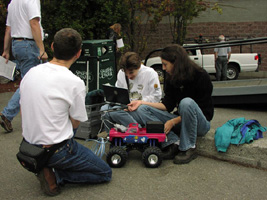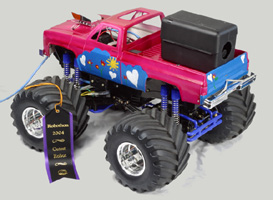 |
Scout at RobothonSeptember 25-26, 2004 Scout's first competition was at the inaugural Robo-Magellan held at Robothon 2004. 
Photo by Barbara Joyce As of 6:00 am the morning of the contest, Scout was working well in parts, but had some "integration issues." After solving many small technical and mechanical challenges, the biggest remaining problem was that we ran out of time trying to figure out how to accurately calibrate Scout's distance and rotation sensors under actual driving conditions. Scout would behave quite reliably, but predicting behavior in advance was not happening. Since it was at least consistent, we figured there was a chance it would work well on a course where a simple route would be effective. Many of the competitors seemed to be in a similar state with their robots, mostly working but with enough problems to make a winning performance unlikely. At 10:00 am, we found out that the field was the mural stage area south of Center House. The starting point was to the side of the stage, on a narrow, angled sidewalk behind the left ramp (as you face the stage from the field). The final cone was straight across the field from the stage, across the far walkway, screened behind a concrete sculpture and protect by several lines of obstacles. There were three bonus cones. There was a pretty accessible 0.9 cone in the general path between the start and end cones. Off to the far left side, in a sloped patch covered in fall leaves was a 0.6 cone. Squarely in the middle of the stage, accessible only to robots that could navigate the narrow ramps, was a 0.2 cone. The weather was overcast, but dry, pretty much ideal circumstances for using the camera outdoors, since we had problems with our filtering scheme and had only a crude idea of a hack for how to shutter down bright light to the camera. The lawn had been recently overcoated with sand, which apparently protects the grass from heavy pedestrian traffic, but also makes the area loose and slippery for robots trying to climb steep hills. Jim and I quickly walked off a simple route that only required two segments that had a plausible chance of getting us close to the cone. Because the cone was screened from view, it would take a very accurate maneuver to get the cone to within visual range. Cathy quickly manually calculated the simple path. Linda helped Cathy verify and refine the path encoding. They got the program ready and downloaded quickly, leaving enough time that Linda and I could try out the program off field to see how the distance and turning angle compared to what we wanted. We found that both the distance and turning calibrations needed to be refined, and also that the speed we were running out wasn't giving Scout enough power to climb slopes very well. So Cathy quickly updated those parameters and downloaded a new program as the preparation period ended. We were randomly selected to start second out of about 8 robots (13 had registered). The first robot was using GPS and couldn't get a good signal, so it wandered off to the side and got stuck. Linda took the tethered safety switch and followed as Scout followed our expected route fairly closely, but veered over toward one of the trees we were trying to go between. We managed to miss the large rocks along the start of the path and even narrowly missed the tree, but then lost speed and traction climbing the steep sandy hill on the other side of the walk. Since we made it across the walkway that goes in front of the stage, we made actual forward progress and thus were in first place after two robots in the first round. Cathy and Linda updated the program to give Scout more power, which would hopefully get us up the hill and also make following behind with the tether more challenging on level ground. Ideally, we would be using the encoders to measure our speed and regulate power to the motors accordingly to give a more constant speed, but time ran out before we could add that feature. Since we had run Scout several times when testing the route, and power was going to be an issue with the steep hills, I ran back to the truck and got the battery charger for use between rounds. Amazingly, at the end of the first round we were still in the lead having made the most forward progress. Many of the robots were trying to use GPS which has many pitfalls, especially at the starting point which was well shielded from the sky by the tall wall behind the mural and trees on either side of the narrow sidewalk leading out from the starting point. The other robots tended to move very slowly and carefully in a seemingly aimless, drunken walk until they got so far off course they couldn't make forward progress. The other robot Jim Culbertson had worked on, with Jim Wright, did move in the right direction, but got blocked by one of the stones along the path. Because the other robots were having such a hard time getting out of the starting area with its many obstacles, the rules were modified to allow teams to choose to start in front of the stage. Doing so took away the opportunity to win the $1000 prize and would place behind robots which completed the course from the official starting point. Since we felt we could get through the obstacles, we choose to continue starting from the official spot. In the second round, Linda chased as Scout successfully threaded the obstacles and made it up the steep, sandy hill that stopped us the first time. Unfortunately, Scout turned a little late thus missing the clear open path across the lawn and instead managed to find a concrete lamppost base with the front bump sensor. This put us about one fifth of the way across the field and widened our lead over the other robots. Linda and Cathy made an adjustment to the path and downloaded the new program. We felt good about our battery state based on how quickly it charged after the first round and the initial test driving, so we didn't re-charge it. The rest of the teams, most or all of which took the easier starting point, didn't manage to get farther than we did. At the start of the third round, one robot started in front of the stage, moved across the lawn, through the obstacles at the edge, over the pedestrian walkway and into a devil's triangle formed by a trash can, lamp post and pillar. It nearly threaded the narrow gap, but got hung up on the trash can and couldn't untangle itself. The crowd had collected and given chase as it made forward progress well ahead of anything else. There was a sigh from the crowd when it got stuck and a hearty round of applause at the tremendous progress. 
Photo by Michael Miller In our third and final run, we turned where we wanted to and headed across the open grass field. Our resulting course was apparently angled away from the target area, which might have been caused by a problem with our angular measurement, or may have been the slope of the grass making it difficult to steer up the hill. To our excitement, Scout persisted in curving to climb the hill as it crossed the lawn. As we made significant forward progress, the crowd joined the chase and clustered around as Linda followed Scout across the lawn, curving toward the target area, through the trees and benches that line the far side of the lawn, over the pedestrian path and straight toward a bench. Scout was just an inch or two too tall to make it under the bench and was stopped just outside the area with the final cone! Had it gone under the bench, I'm not sure how Linda would have followed with the tether, but it generated a lot of crowd interest. We were stopped along the same edge as the leading robot was, but were better centered, so we were a few feet closer than any other robot so far and arguably still in the lead. The other robot, MRToo, that had made progress and got stuck at the same post that ended our second round used the alternate starting point in the third round and made more progress than their previous run, but got stuck off somewhere in the far right hand corner. John McIvor's robot, Merriwether, ran a simple testing mode in the third round and just drove in a straight line across the lawn, up the hill and through the two layers of obstacles. The robot was within visual range of the cone as it was visible from the side of the screening sculpture, but got stuck at an obstacle very close to the cone. He explained to me later that he was using an old test program that just uses his gyro/compass sensor to drive a straight line, and then maybe steer toward the cone if it comes into view. His robot was clearly closer than ours, but we ended in second place by distance to the target. Since no robot completed the course, the judges conferred and made a subjective decision based on largely unspecified criteria which included use of technology. We were awarded third place, behind what I believe to be the third and fourth place robots by distance and time. Our robot was quite fast compared to other robots, even when they weren't wandering back and forth to the unheard call of spotty, imprecise GPS signals. Later, we learned that we were penalized from getting a better ranking because we didn't use GPS. My view is that our robot clearly demonstrated that the challenge could be won by dead-reckoning while the GPS-based robots demonstrated how poorly that strategy worked at the scale of this contest within the confines of the radio-signal obstructions in an urban setting. Scout also won the judges' award for "cutest robot". 
Photo by Michael Miller Perhaps next year we'll strap a GPS on our robot and ignore it as we navigate the course by more reliable methods. Thanks to everyone on the team for helping to create a successful strategy and robot. Cathy, Jim, Linda, Caitlin and Chris Rathe all helped pull this off. Even though we had some luck on that third run, we had a consistent, controllable robot that made far more progress than most of the other competitors, including many would-be contestants that didn't field a robot. No other robot started from the official starting point and got anywhere near as far as we did. We learned a lot from the competition and should we choose to subject ourselves to this again next year, we can build on this year's accomplishments. |
| ©2000-2025 Idle Loop Software Design, LLC. You may not copy or reproduce any content from this site without our consent. |